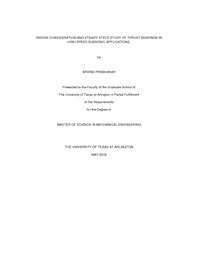
ATTENTION: The works hosted here are being migrated to a new repository that will consolidate resources, improve discoverability, and better show UTA's research impact on the global community. We will update authors as the migration progresses. Please see MavMatrix for more information.
Show simple item record
| dc.contributor.advisor | Kim, Daejong | |
| dc.creator | Prabhakar, Arvind | |
| dc.date.accessioned | 2016-09-28T17:42:44Z | |
| dc.date.available | 2016-09-28T17:42:44Z | |
| dc.date.created | 2016-05 | |
| dc.date.issued | 2016-05-10 | |
| dc.date.submitted | May 2016 | |
| dc.identifier.uri | http://hdl.handle.net/10106/25885 | |
| dc.description.abstract | Thrust bearings are required to perform at high speeds in various turbomachinery applications causing the nature of fluid flow within the bearings to be in high subsonic as well as supersonic regimes. The motivation of this research is to develop a bearing performance prediction model tailored for high subsonic speeds and large Reynolds numbers.
The prime fluid characteristics studied in the thin film for predicting the bearing performance has been achieved by carefully considering inertial, viscous as well as compressible effects within the thin film fluid flow.
Fluid inertia is a vital physical phenomenon that plays an important role in prediction of thrust bearing performance at high speeds. Conventional lubrication modelling of fluid flow by Reynolds equation for high speed applications has limitations due to the assumption of non-inertial nature of flow. Hence, the investigation of high speed performance of thrust bearing requires computational fluid dynamics (CFD) modelling of three dimensional (3D) thin film Navier-Stokes equations.
For the purpose of this research thesis an in house computational solver has been developed that solves three dimensional thin film Navier-Stokes equations to investigate effects of fluid inertia, viscosity and compressibility on performance of thrust bearings in high speed isothermal flow conditions.
The geometrical structure of thin film studied is essentially a 3D fluid volume formed by two rigid sliding surfaces consisting of an inlet region converging with a constant slope and an exit region of constant gap.
A density based segregated solver is adopted to solve the Momentum and continuity Navier-Stokes equations. The comparison of results from the solutions of 3D thin film Navier-Stokes equations with Reynolds equation show that there is a substantial difference between prediction of bearing performance as Reynolds number increases and inertial effects become predominant. | |
| dc.format.mimetype | application/pdf | |
| dc.language.iso | en_US | |
| dc.subject | Fluid film lubrication | |
| dc.subject | Navier-Stokes equations | |
| dc.subject | CFD | |
| dc.subject | Reynolds equation | |
| dc.title | DESIGN CONSIDERATION AND STEADY STATE STUDY OF THRUST BEARINGS IN HIGH SPEED SUBSONIC APPLICATIONS | |
| dc.type | Thesis | |
| dc.degree.department | Mechanical and Aerospace Engineering | |
| dc.degree.name | Master of Science in Mechanical Engineering | |
| dc.date.updated | 2016-09-28T17:44:51Z | |
| thesis.degree.department | Mechanical and Aerospace Engineering | |
| thesis.degree.grantor | The University of Texas at Arlington | |
| thesis.degree.level | Masters | |
| thesis.degree.name | Master of Science in Mechanical Engineering | |
| dc.type.material | text | |
Files in this item
- Name:
- PRABHAKAR-THESIS-2016.pdf
- Size:
- 4.319Mb
- Format:
- PDF
This item appears in the following Collection(s)
Show simple item record


